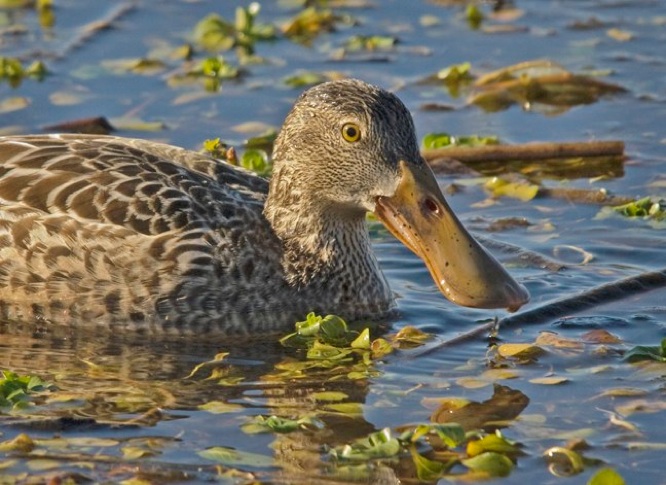A practical guide to bird watching in Sonoma County, California
(Unless otherwise indicated, all phone numbers are in the 707 area code)
A practical guide to bird watching in Sonoma County, California
(Unless otherwise indicated, all phone numbers are in the 707 area code)


Northern Shoveler is hard to miss in any plumage: Its large, broadly spreading bill is distinctive. "Spoonbill" is an alternate common name. Common in Sonoma County in the winter months. Most birds arrive here in September, but records from late August are not unusual. Overwintering birds start to leave in late April. Most are gone by the end of May. Generally not present in June and July, but sporadically reported in all months of the year. Favors freshwater ponds, small lakes, reservoirs, and sewer ponds. Prefers shallow water (especially muddy, slow-moving water), where it may be seen skimming the surface, using the comb-like edges of its bill to strain out small animals and plant matter. May forage in groups of its own kind, but also commonly mixes with other dabbling ducks. Probably most easily seen in Sonoma County at Shollenberger Park. Known to breed in small numbers in the extreme southeast of the county, near San Pablo Bay.
The most obvious feature of the Shoveler, besides the bright coloration of the male, is its large bill, which is longer than its head. Even the drably colored females are obvious among female ducks because of their large bills. The male is distinguished by its bright green head (appearing dark--or nearly black in some lights), golden eye, black back, white breast, and white and chestnut sides--and, of course, its broad-tipped, black bill. Orange feet in both sexes. Females are mostly a scalloped brown but with finer patterning on the head and neck. As noted above, the large (in this case, mottled yellow to orange) bill is distinctive also in females. Unlikely to be confused with any other bird, but males in eclipse plumage (generally late summer through late autumn) can be puzzling because the head will look more black than green and some birds may show a faint pale crescent in front of the eye, suggestive of Blue-winged Teal (Anas discors). Plumage is also more mottled in eclipse. Females may look similar to female Cinnamon Teal (Anas cyanoptera). However, while Cinnamon Teal has a comparatively large (darkish) bill, its bill is never as big as that of the Shoveler. In flight, the long head and bill of the Shoveler are usually obvious and give the bird a back-heavy look. Shovelers also show a blue patch (greyer in the female) on the forewing, which may be visible in flight at close range, and both sexes have a narrow white bar behind the wing patch. The white tail of female may be visible in flight as well.
The challenges of female duck identification (includes a quiz)
Further reading:
Bolander and Parmeter, Birds of Sonoma County California, rev. ed., 2000, p. 31
Brinkley, National Wildlife Federation Field Guide to Birds of North America, 2007, p. 41
Burridge, ed., Sonoma County Breeding Bird Atlas, 1995, p. 40
Dunn and Alderfer, eds., National Geographic Field Guide to the Birds of North America, 5th ed., 2006, pp. 36, 53
Dunn and Alderfer, eds., National Geographic Field Guide to the Birds of North America, 6th ed., 2011, pp. 32, 51
Dunne, Pete Dunne’s Essential Field Guide Companion, 2006, pp. 41-42
Ehrlich, Dobkin, and Wheye, The Birder's Handbook, paperback edition, 1988, p. 66
Fix and Bezener, Birds of Northern California, 2000, p. 83
Floyd, Smithsonian Field Guide to the Birds of North America, 2008, p. 41
Kaufman, Field Guide to Birds of North America, 2000, p. 30
Kaufman, Field Guide to Advanced Birding, 2011, pp. 148, 157, 159
Lukas, Bay Area Birds: From Sonoma County to Monterey Bay, 2012, pp. 13-14
Parmeter and Wight, Birds of Sonoma County California, Update (2000-2010), 2012, p. 6
Peterson, Birds of Eastern and Central North America, 5th ed., 2002, p. 70
Peterson, Field Guide to Birds of Western North America, 4th ed., 2010, pp. 28, 42
Peterson, Western Birds, 3rd ed., 1990, pp. 48, 66
Sibley, Field Guide to Birds of Western North America,1st ed., 2003, p. 78
Stokes, Stokes Field Guide to the Birds of North America, 1st ed., 2010, p. 26
Vuilleumier, American Museum of Natural History, Birds of North America: Western Region, 2011, p. 51
Voice: Cornell Lab of Ornithology: All About Birds--Northern Shoveler
© Colin Talcroft, 2009, 2010, 2011, 2012, 2013
Unless noted, all photos by the author. If you would like to use one of my images, please ask for permission for non-commercial use with proper credit or commercial use with proper compensation.
Female Northern Shoveler, January 5, 2012



Male Northern Shoveler in eclipse plumage (at rear)
Shollenberger Park, Petaluma, October 24, 2009
Northern Shoveler
Anas clypeata
Northern Shoveler, Male (right) and Female pair
1990-2013 Sonoma County data. Graph provided by eBird (www.ebird.org), generated July 29, 2013
EBird reported occurrence in Sonoma County
